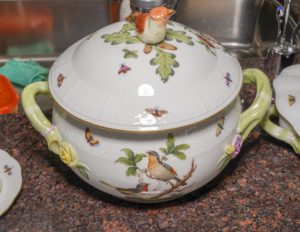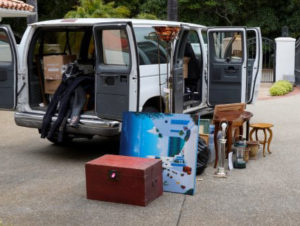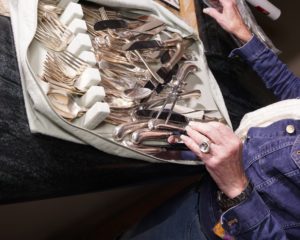 A client cancelled an appointment with me yesterday. He said he felt sick and tired of his family and colleagues suggesting he ‘de-clutter.’ He decided he didn’t care about valuing his stuff. He didn’t want to sell! He is a bibliophile and treasures his library. His kids urge him to get rid of his collection of books, and things about books, because they don’t want to face ‘de-accession’ when he dies. But he’s not done with living. And he’s not done with his books.
A client cancelled an appointment with me yesterday. He said he felt sick and tired of his family and colleagues suggesting he ‘de-clutter.’ He decided he didn’t care about valuing his stuff. He didn’t want to sell! He is a bibliophile and treasures his library. His kids urge him to get rid of his collection of books, and things about books, because they don’t want to face ‘de-accession’ when he dies. But he’s not done with living. And he’s not done with his books.
A friend celebrated the one-year anniversary of the Holiday Fire in Santa Barbara. She feels glad the objects her grown kids left under the house are ‘toast,’ but she misses her mom’s fancy gold edged china. She harbors some guilt about that.
Borderline Gen X’ers and Boomers feel guilty indeed when we open the garage or junk drawer. Tons of recent books advise us to DOWNSIZE. Ironically, we may take those books to Planned Parenthood this year, not our classics.
 I now see this downsizing epidemic as a collective neurosis. I’m here to tell you it’s okay if you do NOT want to downsize. Every generation thinks they have the correct way of living in a home. But I aim to show you that the same phenomena persists through time. In some sense our things define us all. Our things have a Secret Life as part of our personal narrative.
I now see this downsizing epidemic as a collective neurosis. I’m here to tell you it’s okay if you do NOT want to downsize. Every generation thinks they have the correct way of living in a home. But I aim to show you that the same phenomena persists through time. In some sense our things define us all. Our things have a Secret Life as part of our personal narrative.
SOME of the things we love, we love because they resonate with us. Feel free to collect, to display, to touch, to admire, to sense the life our things have lived with us. Our objects are a big part of our life-narrative. We are materialistic because we are material ourselves, and we dream with objects in our dreams.
Two forces work to undermine our Joy of Things:
- One force is our consumer basis, which may lead us o over- collect. If we are 45-75, we came up in a materialistic era. Some of us looked at our things as status markers because we didn’t have much growing up, so to acquire became a revelation. We became midlife achievers! Our generation coined the phrase “retail therapy.”
- The other force involves OLDER people who the current generation brands as “elders” if they collect anything not tech related. But young acquirers, think 30 year-olds and the digital universe they possess, will become Old Acquirers in a different collective universe.
I don’t know much about the thirty-something collective universe, but I do know the concept of TIME in their world seems ever-shrinking.
Learned Time, a skill learned over time, has changed.
For dads and moms of boomers it took at least 30 years to become an expert. For my generations it took a little more than a decade. For today’s 30 year-olds, it takes five years. My Partner’s son works for Google and some of the young members of his team became experts in three years.
I loved Tad Friend’s article “Getting On” in The New Yorker of November 20, 2017. He put the idea this way (and I paraphrase): ‘The median age at tech titans such as Facebook and Google is under 30; the standard job requirement…demands a ‘digital native’ who’s a ‘culture fit.’” And that means ready to become an expert NOW. Thus TIME itself has accelerated when it comes to the cultural norm of accepted knowledge in one’s life.
 I carry certain wisdom in my head about things and the people who own them because I have appraised in thousands of homes for 30 years. Often clients check my valuation reports by googling the thousands of sales and descriptions of objects online. Yes, what the internet contains about a painting is highly useful. I wish that tool existed when I started out; I used books. Now people find researching value very easy.
I carry certain wisdom in my head about things and the people who own them because I have appraised in thousands of homes for 30 years. Often clients check my valuation reports by googling the thousands of sales and descriptions of objects online. Yes, what the internet contains about a painting is highly useful. I wish that tool existed when I started out; I used books. Now people find researching value very easy.
However, I want to point out a funny thing about value; the connection between a person and objects. To understand that connection, someone like me needs learned emotional intelligence to approach a proper valuation. Yes, value is relative! I therefore gleefully join in the sentiment of a relationship between a person and their home’s objects. I observe a certain kind of wealth, a unique personal narrative, which speaks to me through the objects.
Yes, our kids worry that we will to leave them too many things. Their houses already contain their own things. Times, and time, have changed as well as styles of collecting. I’m amused to discover that among the younger set, objects STILL define a personal narrative.
Another great quote from Tad Friend’s article in The New Yorker says “[a person’s] tech creates a series of moats in which digital immigrants eventually drown. Cord–neverers look down on cord–cutters, who look down on land–liners, who look down on AOL addressees like mine. I hope it will eventually seem retro in a cool way, like blacksmithing.” He implies that using objects to convey a personal story is still DONE. We can’t help it. We indeed judge both time and people in this way.
I close my cajoling here.
 Enjoy your objects. Don’t worry about buying books about the life-changing magic of downsizing, a fad that will change with the ages. Tad Friend’s article quotes Goldie Hawn’s character in The First Wives Club, “There are only three ages for women [in film]: babe, district attorney, and Driving Miss Daisy.”
Enjoy your objects. Don’t worry about buying books about the life-changing magic of downsizing, a fad that will change with the ages. Tad Friend’s article quotes Goldie Hawn’s character in The First Wives Club, “There are only three ages for women [in film]: babe, district attorney, and Driving Miss Daisy.”
Remember I told you objects are a part of life. Hang onto those things that DO remind you of that life-adventure.
Great article for one who is a collector👏🏻👏🏻